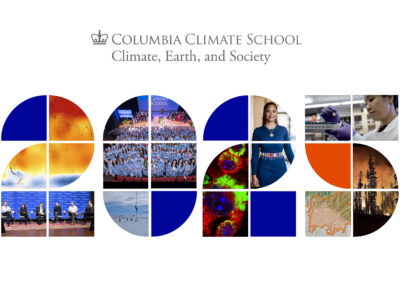By Doug Phillips and Cassie Xu
On March 13, the fourth seminar in the Earth Institute’s Sustainable Development Seminar Series for the 2012-2013 academic year took place at Columbia University’s Low Library. The event, titled “Ch Ch Ch Changes – recent trends in temperature extremes and hydroclimate,” brought together experts in the fields of climate change and hydrology to discuss emerging trends in global weather events and drew in more than one hundred attendees. Peter Schlosser, Earth Institute deputy director and Director of research and Vinton Professor of Earth and Environmental Engineering, introduced the event, and presentations were made by Gavin Schmidt, deputy chief of the Goddard Institute for Space Sciences, NASA, and co-founder of RealClimate.org; Richard Seager, Palisades Geophysical Institute/Lamont Research Professor at the Lamont Doherty Earth Observatory; and Jason Smerdon, Lamont Associate Research Professor at the Lamont Doherty Earth Observatory followed.
Schlosser introduced the topic and framed the discussion around recent extreme weather events and increasing temperature trends that have been reported in the media. Schmidt elaborated by highlighting changing trends in climate anomalies and temperature trends since the 1950s. Schmidt, who was awarded the American Geophysical Union Climate Communication Prize and named the EarthSky Science Communicator of the Year in 2011, noted that while warming had not occurred uniformly, it can be said that on the whole the planet has been warming consistently since the 1950s. All panel members indicated that rising temperatures are of particular concern in terms of their effect on glaciers, and subsequently on ocean temperatures around the world. Higher ocean temperatures contribute to the frequency and intensity of extreme weather events, which can significantly impact planting seasons for food and other crops. Schmidt noted that the increasing temperatures observed in recent decades are a result of increasing greenhouse gases.
Turning to Smerdon, the discussion focused on models for displaying temperature changes, and predicting future trends. “These models show not only that temperatures have been increasing at a steady rate, but that there is no indication these increases are slowing down,” Smerdon said. Using the Western Pacific as an example, Smerdon explained that “the increasing global temperatures play an important role in the circulation of water vapor, and have a sizeable impact on rainfall patterns.” To better communicate the nature of this impact, Smerdon made an analogy to the use of steroids in professional baseball. While home runs were hit in the pre-steroid era, they are far more frequent and travel much further in the post-steroid era. Similarly, large storms are possible and likely without climate change, but occur more frequently and are far more intense with the “steroid” of greenhouse gases. Smerdon concluded that given the evidence that the planet will continue to get hotter, now is the time to adapt and mitigate the negative effects of climate change.
Following Smerdon’s presentation, Seager moved the focus to the effects of climate change on drought. He indicated that “in recent years, large scale droughts throughout the world have caused water shortages and resulted in billions of dollars lost in agriculture. New trends in precipitation caused by climate change are causing the planets’ wet areas to get wetter and dry areas to get drier.” Seager further explained the relationship between polar regions and greenhouse gases. “Polar regions act like a mirror for the sun’s heat, reflecting it back in to the atmosphere. However, greenhouse gases function as a ceiling for this heat, trapping it at a level where it is able to increase temperatures on a global scale.” The panel agreed and emphasized that now is the time to quantify and set thresholds for carbon in the atmosphere. However, reaching a consensus between scientists, national governments and world leaders on these thresholds is easier said than done.
The next event in the Sustainable Development Seminar Series will be “The Millennium Villages Project: Designing Complex Systems in Poor Rural Communities” on April 4 from 4-6 p.m. in the Columbia University Morningside Campus Faculty House. Speakers include Jeffrey Sachs, director of the Earth Institute, Columbia University; Vijay Modi, professor of mechanical engineering at the Fu Foundation School of Engineering and Applied Science; and Prabhjot Singh, director of systems design for the Millennium Villages Project and co-chair of One Million Community Health Workers.



